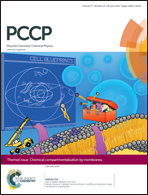Anion resonances and above-threshold dynamics of coenzyme Q0†
Abstract
Temporary radical anions (resonances) of isolated co enzyme Q0 (CQ0) and their associated above-threshold dynamics have been studied using frequency-, angle-, and time-resolved photoelectron imaging (FAT-PI). Experimental energetics and dynamics are supported with ab initio calculations. All results support that CQ0 exhibits similar resonances and energetics compared with the smaller para-benzoquinone subunit, which is commonly considered as a prototype electrophore for larger biological para-quinone species. However, the above-threshold dynamics in CQ0 relative to para-benzoquinone show significantly enhanced prompt detachment compared with internal conversion, particularly around the photoexcitation energy of 3.10 eV. The change in dynamics can be attributed to a combination of an increase in the shape character of the optically-accessible resonance at this energy, a decrease in the autodetachment lifetime due to the higher density of states in the neutral, and a decrease in the probability that the wavepacket formed in the Franck–Condon window can access the local conical intersection in CQ0 over the timescale of autodetachment. Overall, this study serves as a clear example in understanding the trends in spectroscopy and dynamics in relating a simple prototypical para-quinone electrophore to a more complex biochemical species.


 Please wait while we load your content...
Please wait while we load your content...